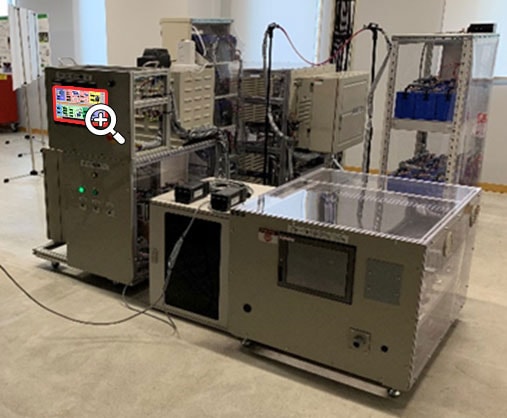Presentation of Use Example: Kanazawa Institute of Technology
Electrothermal coordinating DC micro-grid system that uses renewable energy using the EZA series of bidirectional DC-DC converters
A community model demonstration trial with a renewable energy best mix is underway at the Hakusanroku Campus (located in Hakusan City, Ishikawa Prefecture) of the Kanazawa Institute of Technology to achieve carbon neutrality, locally produce energy for local consumption, and enhance energy resilience.
By using the EZA series of bidirectional DC-DC converters and other components, autonomous and distributed control that can independently charge and discharge each storage battery, DC power generation by a Stirling engine that uses a biomass system as a thermal energy source, and DC-applied MPPT control with an EL diagnosis function for solar power generation are achieved.
| Overview of the DC Microgrid System |
|---|
|
・DC bus voltage: 360 V (± 180 V) ・Photovoltaic system: 1.76 kW + 5.00 kW ・Wind power generation system: 300 W ・Electric bicycle power generation: 260 W ・Storage batteries (LiB): 7.4 kWh + 7.2 kWh ・Storage batteries (lead): 8.6 kWh ・Biomass system: 58 kW (50 Mcal/h) ・Biomass (Stirling engine) 7.1 kW (max.) ・Biomass (thermal power generation): 240 W ・EV bidirectional high-speed charger and power supply: 6.0 kW |
| Roles of the EZA series of bidirectional DC-DC converters in the DC microgrid system |
|---|
|
・Autonomous and distributed control of storage battery charging and discharging ・MPPT control of photovoltaic power generation and EL direct current voltage control ・Biomass Stirling engine DC power supply control |
* For details of the DC microgrid system, please submit an inquiry to the email address below.
- Email: kitor@neptune.kanazawa-it.ac.jp
- Contact Person: Collaboration Promotion Office, Research Development & Promotion Division, Kanazawa Institute of Technology


